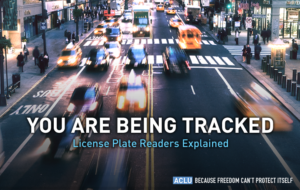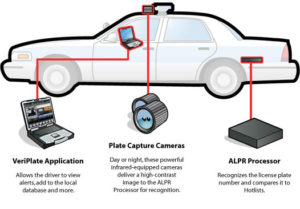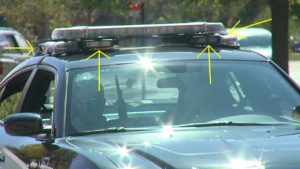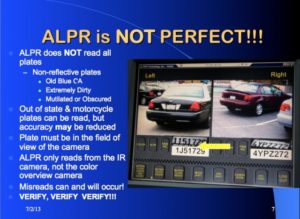Orange County Automatic License Plate Reader Systems
Orange County Automatic License Plate Reader Systems
What are Automatic License Plate Readers?
An Automatic License Plate Reader, or ALPR, is a high-speed camera system, which is n computer-controlled, and automatically captures images of every vehicle plate that comes into view. ALPRs can detect when a license plate is in the camera’s view, capture an image of the car and its surroundings (including the plate), and convert the image of the license plate into alphanumeric data—in effect “reading” the plate. They use the same technology developed for toll roads – reading plates and providing information to match against a database in the system.
ALPRs are generally mounted on streetlight poles, but can also be mounted on bridges or overpasses, scanning every car below, as well as on mobile police cars. ALPRs record data on each plate they scan, including not only the plate number but also the precise time, date and place it was encountered. The cameras can scan up to 1,800 license plates per minute, day or night, allowing one squad car to record more than 14,000 plates during the course of a single shift, or an entire agency to scan over a billion records per year.
ALPR systems are expensive. Each camera can cost as much as $30,000, and entire systems can be several times that.
Where are they used?
The ALPR systems are used and purchased all over the United States. In Orange County, California, the City of Irvine, Laguna Beach, Huntington Beach, Long Beach, Anaheim, Fullerton, and the OC Sheriff’s Department, all use Automatic License Plate Reader Systems to scan automobile license plates and check numbers against the State of California database of stolen or wanted vehicles, and can match plates to arrest warrants, stolen license plates and missing persons that have been matched with a plate. It is also used to gather information related to homeland security investigations, electronic surveillance, suspect interdiction and stolen property recovery.
License-plate readers make it extremely easy for the police to find stolen cars and catch up with people with expired registration, licenses or active warrants.
The Boston Globe found at least ten repossession companies in Massachusetts that used license-plate readers to do their job and find cars for repossession. (Todd Hodnett, the director of government affairs for Vigilant Solutions, says he estimates about one in four repo companies nationally operate license-plate readers.)
Certain agencies, like the ACLU, and The Electronic Frontier Foundation (EFF) are concerned about the use of ALPRS systems and how they are used. The EFF submitted a request in 2014 for information about the Oakland Police Department’s use of license-plate readers. That advocacy organization found that the readers were deployed disproportionately often in low-income areas and in neighborhoods with high concentrations of African-American and Latino residents.
The police agencies point out that the system has helped police solve crimes. Lenders find it economic because it leads to the rapid repossession of vehicles. However, there’s a lack of consistent state laws to prevent local police from accessing billions of commercially-gathered license-plate scans.
As a result, two new laws were passed in California requiring that every police agency come up with a policy, that must be posted publicly, disclosing the use of a camera license plate reader system, and disclosing how long the information will be kept for. On January 1, 2016, those new laws went into effect in California:
S.B. 34 requires agencies that use automated license plate recognition (ALPR) or access ALPR data to publish privacy and usage policies;
S.B. 741 requires public policies for cell-site simulators, a type of cellphone tracking technology often referred to as “Stingrays” and “Dirtboxes.”
These policies must be posted “conspicuously” on their websites.
Orange County Automatic License Plate Reader Systems policies.
The following policy was developed and posted by the Orange County Sheriff’s Department (OCSD) and appears in the OCSD Manual:
463.3 OPERATIONS Use of an ALPR is restricted to the purposes outlined below. Department members shall not use, or allow others to use the equipment or database records for any unauthorized purpose (Civil Code § 1798.90.51; Civil Code § 1798.90.53). (a) An ALPR shall only be used for official law enforcement business. (b) An ALPR may be used in conjunction with any routine patrol operation or criminal investigation. Reasonable suspicion or probable cause is not required before using an ALPR. (c) While an ALPR may be used to canvass license plates around any crime scene, particular consideration should be given to using ALPR-equipped cars to canvass areas around homicides, shootings and other major incidents. Partial license plates reported during major crimes should be entered into the ALPR system in an attempt to identify suspect vehicles. (d) No member of this department shall operate ALPR equipment or access ALPR data without first completing department-approved training. (e) No ALPR operator may access department, state or federal data unless otherwise authorized to do so. (f) If practicable, the deputy should verify an ALPR response through the California Law Enforcement Telecommunications System (CLETS) before taking enforcement action that is based solely on an ALPR alert.
The policies of Orange County Automatic License Plate Reader Systems, and throughout California, are summarized as follows:
| AGENCY | RETENTION PERIOD |
|---|---|
| Alhambra PD | 1 year |
| Anaheim PD | 1 year |
| Carlsbad PD | 1 year |
| Claremont PD | 2 years |
| Cypress PD | 1 year |
| Elk Grove PD | 1 year |
| Escondido PD | 2 years for mobile systems; 1 year for fixed systems |
| Fontana PD | 2 years |
| Fountain Valley PD | 1 year |
| Fullerton PD | 1 year |
| Glendora PD | 1 year |
| Huntington Beach PD | 1 year |
| Imperial PD | 1 year |
| Irwindale PD | 1 year |
| La Habra PD | 1 year |
| Los Angeles Sheriff’s Department | 5 years |
| La Verne PD | 1 year |
| Long Beach PD | 2 years |
| Los Alamitos PD | 1 year |
| Monrovia PD | 1 year |
| Orange County Sheriff’s Department | 2 years |
| Oxnard PD | 1 year |
| Pasadena PD | 2 years |
| San Bernardino PD | 1 year |
| Sierra Madre PD | 1 year |
| Simi Valley PD | 1 year |
| Upland PD | 1 year |
| Ventura County Sheriff’s Department | 1 year |
| West Covina PD | Not stated |
| Westminster PD | 1 year |
| Woodland PD | 1 year |
Source: Department policies
Further reading on Orange County Automatic License Plate Reader Systems:
http://www.latimes.com/socal/coastline-pilot/opinion/tn-cpt-et-0212-hansen-20160212-story.html
http://www.scpr.org/news/2016/04/18/59627/license-plate-readers-capture-loads-of-data-how-lo/
http://www.huntingtonbeachca.gov/government/departments/pd/documents/automated-license-plate-reader-policy.pdf
http://lagunabeachcity.granicus.com/MetaViewer.php?view_id=3&clip_id=386&meta_id=29862
Eyes on the Road (The National College of DUI Defense Blog)
https://www.ncdd.com/blog/59a09284a6ec61f423fdb390/eyes-on-the-road-automatic-license-plate-readers
http://www.cityofirvine.org/irvine-police-department/automated-license-plate-reader-alpr-30326
Here are 79 Surveillance Tech Policies for CA Public Safety Agencies — But Where Are the Other 90?
Contact our Orange County DUI Lawyer, Robert Miller, for questions about the Orange County Automatic License Plate Reader Systems currently in use.





